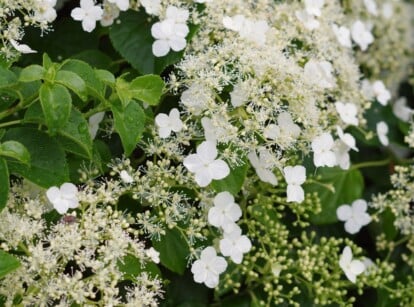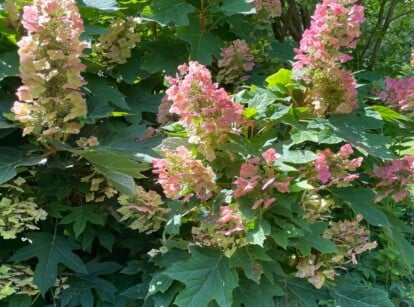Myth or Fact: Can You Turn Hydrangeas Blue With Pennies?
Have you heard that you can turn hydrangeas blue by keeping them planted with a penny? There are a number of hydrangea hacks that claim to improve blooms, or keep their beautiful blue blooms going strong throughout the season. In this article, gardening expert and hydrangea enthusiast Jill Drago examines if planting pennies in the soil actually works.

Contents
Gardeners of every variety love a new trick that may make their life a bit easier. Lately, the internet has been full of interesting hacks that may or may not be true. When it comes to hydrangea flowers and their colors most gardeners are often willing to give anything a try!
Have you heard the gardener’s trick of adding pennies to your garden and you will magically end up with blue hydrangea flowers? This gardening hack seems interesting to me because I doubt there is a home that doesn’t have a spare penny or two hanging around, making this a trick that easy to try for anyone!
So, is the penny trick a myth or a fact? Will this everyday coin change the color of your hydrangea flowers? Or will it just be a waste of money? Let’s take a look at what makes this a good idea or another gardening myth!
The Short Answer
If you had great hopes and aspirations for using your spare change to turn your hydrangeas blue, I am sorry to report that you will be better off saving your pennies to purchase some new plants instead. No, pennies will not turn hydrangeas blue. The key to beautiful blue blooms is acidic soil, and there is no evidence that pennies will make your soil any more acidic than it was before, despite anecdotal reports. The element you need in your garden to produce blue flowers is aluminum, not copper.
The Long Answer

Let’s take a look at the actual penny. Pennies used to be made entirely of copper, but that is not the case anymore. Now pennies are actually made mostly of zinc with a copper coating.
Even if you had tons of copper pennies, it would be nearly impossible to have enough pennies in the ground to even acidify your soil at all, let alone turn your flowers blue.
So yes, while you may have heard this tip in local gardening groups, or a friend that swears by it, it’s far more likely that their blooms stay blue through their soil’s nutrient levels.
Copper and Plants

Copper is a micronutrient that is essential for plants. It aids in the production of seeds as well as the production of chlorophyll.
When it comes to the beautiful blue hydrangea flowers we are talking about here, we know that the soil pH should be acidic. Copper actually tends to be deficient in acidic soils, which begs the question: if I add copper to my soil will it actually make it sweeter, or more alkaline?
Copper is found in many fungicides, and is also used to keep slugs and snails out of your garden. If you apply copper fungicides too frequently your plant could end up with what is called copper toxicity. The plants will suffer and will have stunted growth. This stunted growth may appear blue, but this is not the blue we are going for here.
Aluminum

The element responsible for bright blue blooms is aluminum. The rumor on the street is that the US mint experimented with aluminum pennies back in the 1970s, but are no longer in existence today. This may be where the myth started, however, these pennies would not provide enough aluminum to blue your flowers.
Acidic soil has more available aluminum within it. This means there is more aluminum available for the plant to take up, and eventually turn your flowers blue.
When your soil is more alkaline there will be an abundance of phosphorus, which is great for boosting flowers, but phosphorus can limit the uptake of aluminum. This will make it far less likely for beautiful blue flowers.
How Can I Turn Hydrangeas Blue?

Hydrangea macrophylla and Hydrangea serrata are the two types of hydrangea species that are sensitive to the pH of your soil. If you have one of these two species planted in your garden, you are off to a good start.
White flowering varieties will not change color no matter what you do. If you are really looking for a blue flowering hydrangea I suggest planting a blue variety. It will only be more difficult if you plant a purple variety or pink blooming variety that will slowly change color for you in acidic soil.
Check Your Soil PH

Checking the pH of your soil using a soil test is the next step. This test will tell you if you have acidic or alkaline soil. From there you will be able to figure out what you need to add to your soil to make it more acidic, if anything.
Soil tests can be done at any point in the year, so this is a great task to do in the winter. You will get your results in plenty of time to make a plan for your garden in the season to come.
Add Compost

Adding compost is a step you can take no matter what the result of your soil test is. Over time compost, and other organic material, will help to lower the pH of your soil while also enriching it. Adding compost to your soil has so many benefits.
The greatest benefit, in my opinion, is the nutrients your plant will begin to receive from the organic material found within the compost. It is also the easiest way to improve your soil structure and hold more water in sandy soils, or help with drainage in clay soils.
Use Aluminum Sulfate

If you have neutral or alkaline soil, you can use a soil acidifier or aluminum sulfate according to the package directions to change your flowers blue. Keep in mind that the changing of your soil pH will likely take more than one season.
Soil acidifiers are a slow release granular formula, it is important to use the package directions or you could burn the root system If you plan on using aluminum sulfate a safe application rate is one tablespoon per gallon of water. Apply this as a drench around the roots of your hydrangea in the spring.
Final Thoughts
Garden hacks, such as these, more often than not end up being myths. Yes, there are a few that may work, depending on the myth you are testing. However, on the rare occasion that they are proven to work, it is still almost always more efficient and effective to follow along with traditional gardening practices.









